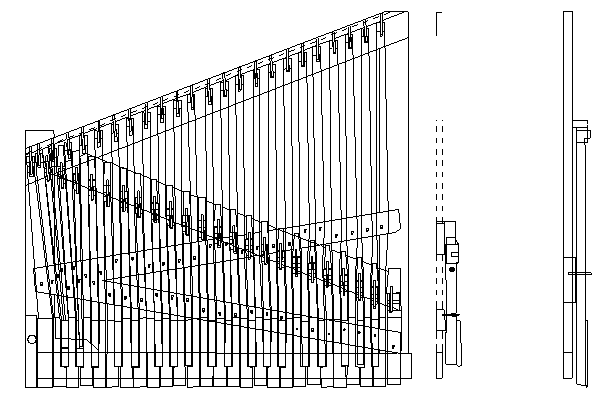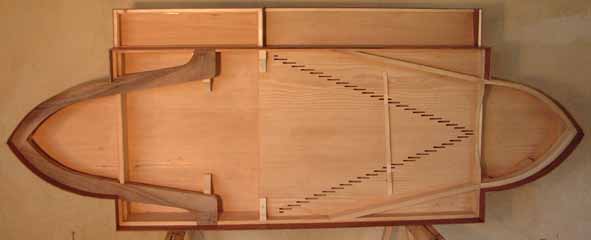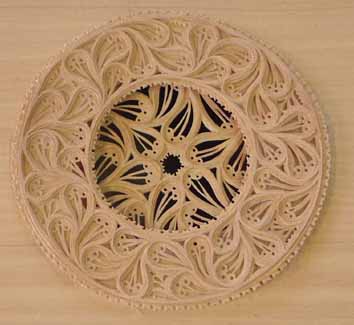| home | instrumentengallerie | restaurierung/ forschung | verleih | CDs | cembalokauf ratgeber | besucht uns | präsentation | Kontakt | links |
MAKING THE 1690 CRISTOFORI OVAL SPINET COPY


After the discovery in 2000 of the 'missing' Cristofori oval spinet made for the Medici in a palazzo once belonging to the antiquarian Bardini, the instrument was transfered to the Galleria dell'Accademia in Florence (famous for housing the Michelangelo statue of David) . The oval spinet is one of two very similar instruments, the other is dated 1693 and is now in the Leipsig instrument museum. The Galleria dell'Accademia includes a gallery of musical instruments of the conservatory, comprising the vestiges of the Medici collection of musical instruments. These include a famous ebony harpsichord also made by Cristofori for the Medici.
Although, as can be seen from the above photo, the instrument looks a bit of a wreck, in fact it is in a much less altered state than the Leipsig instrument, which had been changed to accomodate extra keys, susequently removed. Also the bridges of the Leipsig instrument have been replaced, so the present string lengths and plucking points are not a reliable indication of Cristofori's original plan for this instrument, unlike the Florence spinet which conserves its original bridges and nuts.
It was decided to carry out a series of analyses and measurements, incuding x-rays, analyses of the woods and metals used. Also I made a CAD plan of the instrument and keyboard. This was done by mounting a laser pointer on a system of sliding beams mounted above the instrument, and reading off the x and y coordinates of various points (along the edges of the case, bridges etc. and the pin positions) from metal rules (the system would be suitable for automization given time and money). The positions and dimensions of internal parts were taken from the full size x-ray and direct measurement (through cracks and openings in the case).
Because the instrument was made for the Medici, Cristofori evidently chose the most expensive materials available, Madagascan rosewood (dalbergia baroni) for the case, with ebony mouldings, and ivory keys with ebony accidentals. As always Cristofori used cypress for the soundboard. The baseboard and internal parts are made of silver poplar (populus alba) and fir (abies alba), except for the wrestblock which is of walnut. These same woods were used for the copy. The curved sides have a laminated construction with a central layer of vertical grained poplar (about 1mm thick) around which a veneer (little more than 1mm thick) of rosewood is glued.
The instrument has two 8' registers with the strings for the lowest note in the middle of the instrument. going up the keyboard the pairs of strings for each note are on alternate sides of the centre, so the keys successively become longer and longer for the even keys, and shorter and shorter for the odd keys (see the keyboard plan). The keyboard slides backward and forwards in the case with 3 positions, and a clever system of cutouts in the keys mean that in the back position only the outer strings (the shorter ones) of each pair are playing. In the middle position both registers are playing. In the front position only the inner strings of each pair are playing (the longer strings). Each key is guided at the back by a tongue of wood that also acts as a rest for the jacks that are not playing. I am preparing some animated gifs to illustrate how this works. For now you can view the three positions of a shorter key and a longer key.
We (Kerstin Schwarz and Tony Chinnery) were commisioned to make a copy of the spinet for the museum. Below are some photos of the instrument in construction. The parts missing from the original (jackrail and some mouldings) were reconstructed using the Leipsig spinet as a model. We also wrote an article for a book on the spinet (published by Sillabe)which is on sale in the museum bookshop. Download our article in Word . An interresting finding is that Cristofori was very precise in the layout of the stringband of the spinet, the string lengths and plucking points correspond very closely to those of harpsichords he made 30 years later. Details can be read in the article. The book also contains articles by Gabriele Rossi-Rognoni (the curator of the musical instruments), Giuliana Montanari (who has done much research on the Medici archives), and Grant O'Brien (the relationship between the design of the instrument and the units of measurement). .
 |
 |
 |
The radiograph |
the CAD plan |
The Keyboard CAD plan |
 |
 |
 |
 |
|
The completed frame |
The case with the sides on | The rose (ready to glue on) | With the soundboard in |
Some Links to pages on the spinet:
Conserving the Oval Spinet by Grant O'Brien
Analyses of the spinet
Description of the spinet
Conserving the spinet another article by Grant O'Brien
Tony Chinnery Via Padule, 93 Vicchio(FI) 50039 Italy Tel:39-0558407817
neue email Addresse:
![]()